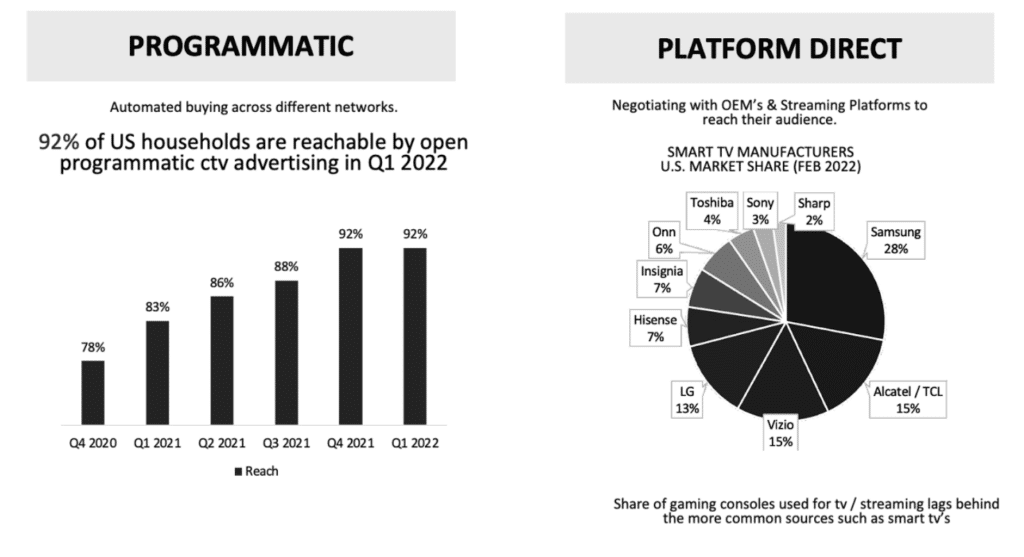It’s impossible to ignore the explosive growth of streaming. Where there’s an audience, there are marketing opportunities. According to the Interactive Advertising Bureau Inc. (IAB), “ad spending on connected TV platforms is expected to expand 39% to $21.2 billion this year, making it the fastest-growing video channel.”
So, is it time to add OTT and CTV to your marketing campaigns? We explored the streaming advertising landscape in our recent webinar: How to Successfully Incorporate OTT/CTV in Marketing Campaigns. It features Bridget Hall, Director, Planning at M&C Saatchi Performance; James Boone, Sr. Sales Engineer at Branch; and Sam Edwards, Product Marketing Manager at Branch.
First, let’s get some definitions squared away.
OTT = over-the-top
OTT is the delivery of TV and video content directly from the internet. Users don’t have to subscribe to a traditional cable or satellite provider to access this content. Instead, they can watch it on many devices, including tablets, mobile phones, laptops, desktops, and televisions. Streaming services like Netflix, Hulu, and Amazon Prime as well as Disney+ and NBC’s Peacock are all considered OTT.
CTV = connected TV
CTV refers to a device that connects to — or is embedded in — a television that supports video content streaming. Think: Sony or Samsung smart TVs, or connected devices like Roku, Amazon Fire TV, Apple TV, Xbox, or PlayStation.
LTV = linear TV
LTV, on the other hand, is the traditional system in which a viewer watches scheduled TV programming when it’s broadcasted and on its original channel. LTV possesses the largest market. However, its reach is fragmented due to the increasingly competitive television landscape.
The OTT and CTV space is ripe for innovation. One of our favorite recent innovations is smart TVs and platforms like Roku using content recognition to overlay calls to action. And that’s just the tip of the iceberg when it comes to the marketing potential in this space.
The programmatic TV ecosystem
The growing popularity of OTT and CTV viewership offers more precise targeting than linear TV. Linear TV measurement is archaic, still relying on panels and segments, while OTT and CTV platforms offer built-in ad measurement tools. This means OTT and CTV platforms have better data about their viewers. Providers are able to target ad inventory based on specific shows, viewers, demographics, and much more.
There are two main ways to buy CTV inventory:
- Programmatic: automated tools to buy video inventory across many different networks or publishers.
- Direct buy: negotiating your ad placements and transacting directly with a streaming service like Roku or an original equipment manufacturer (OEM), like Samsung.
Brands might be interested in exploring both media types. While there’s no simple answer as to what will work best, the advantage of buying programmatically is the ability to run across diverse networks and, ultimately, achieve audience discovery outside of one specific walled garden or narrow audience.
Buying directly from OEMs may require a cost per mille (CPM) or a flat-fee buying model. This type of spend isn’t applicable if you are looking to drive mobile conversions. But if you have an endemic app on a CTV, then going direct offers ad formats that programmatic wouldn’t be able to access.
Programmatic TV can reach 92% of U.S. households so it is very easy to test and scale up. With programmatic, the ability to target with greater precision and to personalize your message for maximum impact means there’s a lot less waste. Something else important to note is that leveraging OTT or CTV in campaigns isn’t restricted to big brands with hefty marketing budgets like is often true for linear TV.
Courtesy of M&C Saatchi Performance
Let’s consider an example of a woman browsing new shoes on Macy’s website on her laptop at home. After a bit of browsing, she closes her computer, turns on the TV, and chooses a show on her Roku. This show uses the same IP address as her computer. Can you guess what ad pops up before her TV show? A Macy’s ad. Inspired, our shoe lover grabs her mobile phone and pulls the trigger on the shoes she was eyeballing. And thanks to the interconnected data at play, Macy’s knows exactly how to attribute her shoe purchase with no guesswork required.
The lesson here is this: The key to getting OTT advertising to work for you is to understand it is just one aspect of your customer journey through web and mobile traffic.
You can use device identifiers, website retargeting, and IP address targeting to connect TV traffic with online marketing efforts. Proper attribution and targeting are now possible, which help run efficient campaigns on smaller budgets.
“We’re seeing that it [CTV] is a supplement on top of those core, efficient channels like search. It’s interesting to see those work together and, in theory, the more that you’re advertising on CTV, it’s really going to prompt people to take the next step and search for your brand on a mobile environment.”
— Bridget Hall, Director, Planning at M&C Saatchi Performance
Get set up for success
Here are a few things to keep in mind as you build out a CTV or OTT marketing strategy.
Measurement and attribution
Your OTT marketing strategy is only good if it can have credible measurement. Without accurate measurement across devices, platforms, channels, and media, it is hard to run and manage omni-channel campaigns. When you have cross-device attribution visibility, you’re able to get the most accurate level of attribution because you know all the different channels that people came from.
“Part of getting attribution right in CTV within a household is knowing all the different touch points they have within the household. So if you’re not focusing on email as a channel, SMS push notifications as a channel, desktop games or applications as a channel, websites as a channel, you won’t see the whole picture.”
— James Boone, Sr. Sales Engineer at Branch
One last big thing to think about when starting a CTV campaign is configuring the right events to track in the app. Tracked events are incredibly important and should be properly implemented. After all, you can’t manage or optimize what you don’t measure.
Ad creative
There aren’t any “accidental clicks” in OTT. This means your audience has to be very motivated by your proposition to take action. The advertising needs to be compelling.
Here are a few best practices:
- Don’t take a concept you’ve been running online and try to make it fit into a TV environment. They are two vastly different mediums.
- Make your ad creative more content-driven and entertaining. It doesn’t need to be a hard sell, but to get users to the app, your ad creative should be clear about their next step. Think: logo presence, a QR code, or app store logos.
- Create different storylines and test different video lengths. The digital A/B testing strategy mindset can also apply to TV.
- Create a solid naming strategy for your creatives and include those names in the attribute. That way, down the road, you can easily categorize the creative and splice the data into different views. For example, you can categorize by specific target audience or by viewers who watched specific genres or categories of content.
Testing
There’s a misconception that, to get a large presence, OTT and CTV advertising is more expensive. In fact, campaigns aren’t expensive if the ROI is positive. You just have to understand the investment and metrics first. Then do a small test to see if programmatic TV works for you. Think outside the box and experiment while also being mindful about different placements and campaign variations.
“With the right measurement, you can quickly identify successful channels and successful placements and then from there, scale. But what’s key is that you have to be able to set the right goals and know the milestones you’re trying to hit. Tactically, test small, test often, test many different times and many different ways to see what works and then scale once you’ve found that secret sauce for your brand.”
— James Boone, Sr. Sales Engineer at Branch
When you select a partner to build out, test, and launch CTV campaigns, evaluate a programmatic partner’s ability to reach the target audience and to measure success. View-through attribution is necessary because streaming is not a clickable environment, so when setting up campaigns, discuss the lookback window you want to analyze. You can test different windows and even run a test with two CTV vendors side by side to get a comparison point. It’ll give you a better understanding of how certain metrics are impacted and how they can be optimized. The only point of caution is that frequency tracking is a challenge. If you run five to six platforms into CTV inventory, it makes it much harder to control how many times your users are exposed to an ad.
“It’ll be an experiment in the next two or three years to figure out, is it QR codes? Is it something else? How do you acknowledge and get more participation? And would someone want that when they’re seeing an ad in that TV environment?”
— Bridget Hall, Director, Planning at M&C Saatchi Performance
Privacy
Privacy changes have been wreaking havoc on mobile marketing for years, but streaming provides some respite to the upheaval. There’s a huge opportunity to target audiences on streaming that is becoming less available on mobile devices.
“The biggest privacy change in the market is the Apple iOS, but within the CTV space, the concept of ‘Apple’ really doesn’t really exist, so that’s why people have migrated to this space because of privacy changes.”
— James Boone, Sr. Sales Engineer at Branch
What’s next for programmatic?
Streaming publishers have announced a few very exciting evolutions in 2022:
- More interactive ad units are coming. For example, YouTube will be pushing CTV ad units to mobile or custom creative. This means when you’re working with a third party, you could enable viewers to pick their own ending to a commercial.
- Disney and Netflix announced ad-supported video on-demand (AVOD) tiers are coming. This means the inventory available to marketers will vastly expand. It might even lead to sequential messaging.
- First-party data can be applied to Roku’s OneView, for example, to find audiences on different networks and streaming environments. The ability to bring first-party data to the table is quite a unique capability and advantage.
- NBCUniversal (NBCU) is rolling out a programmatic ad portal. This means exclusive access for Peacock viewers and the ability to serve ads across NBCU’s entire portfolio of TV and digital properties. Also, this signals that CTV will be geared toward performance marketers because CTV providers are touting the ability to work with mobile measurement partners (MMPs) for visibility into downstream metrics and to optimize for mobile KPIs and acquisition KPIs.
“What this indicates to me is that more and more CTV advertiser partners have done their best to come to the marketplace with a proposition that’s geared toward advertisers who need to drive CPA, efficient installs, and advertising capabilities really geared toward performance marketers and that’s really evolved over the past year or two.”
— Bridget Hall, Director, Planning at M&C Saatchi Performance
Want to learn more about the future of streaming advertising? Check out the webinar: How to Successfully Incorporate OTT/CTV in Marketing Campaigns


